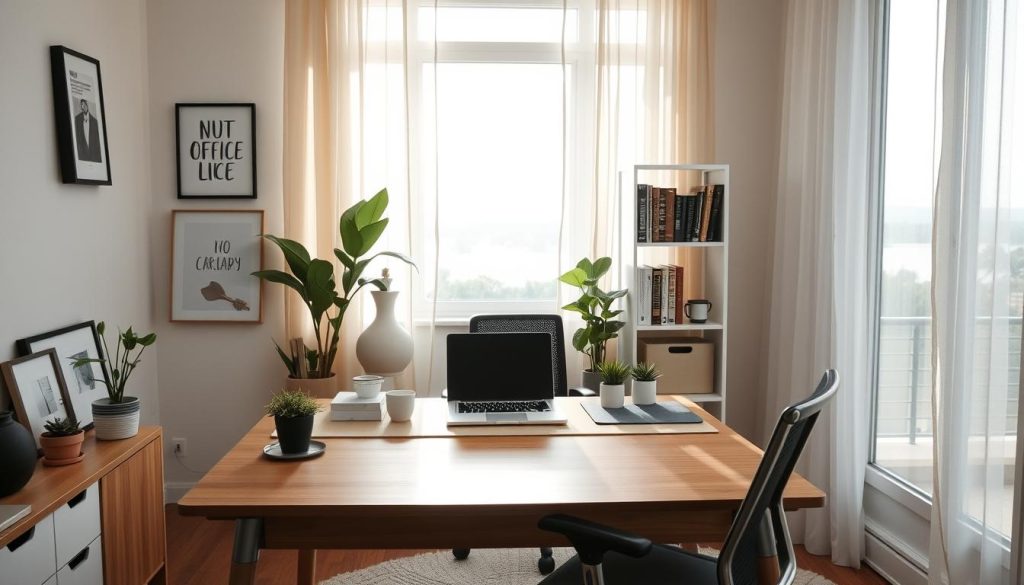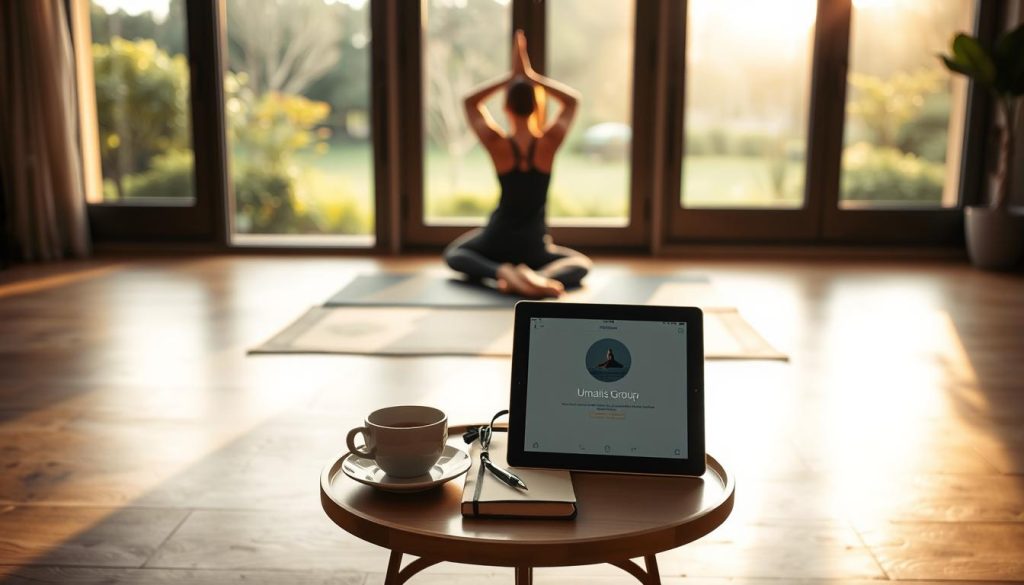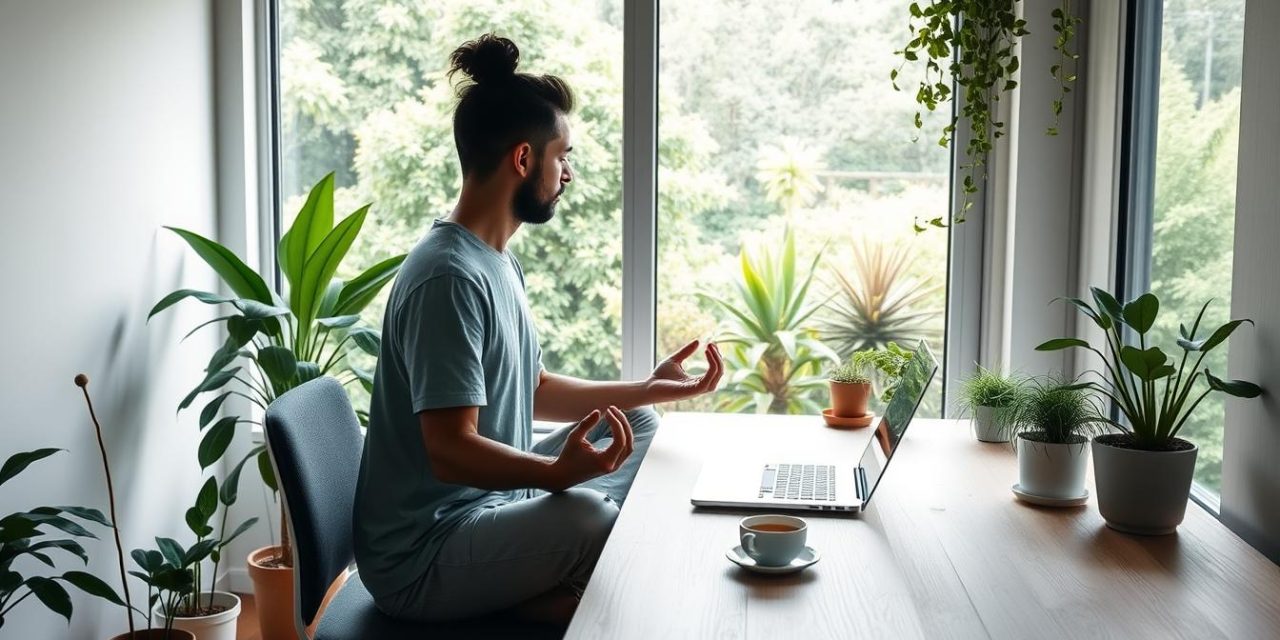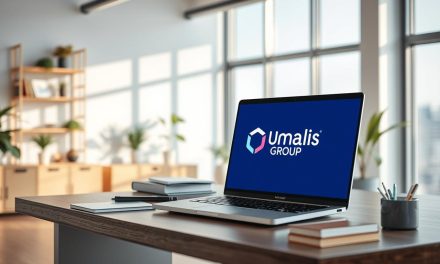Did you know 78% of independent professionals in France report blurred boundaries between work and personal life within their first year? This startling statistic reveals a hidden cost of the flexible career path millions now pursue. While freelancing offers unmatched freedom, it demands intentional strategies to prevent burnout and sustain success.
The absence of office routines or team support leaves many overworking. A 2023 study found solo workers average 2.7 hours more weekly than traditional employees. Without clear systems, what begins as autonomy can spiral into exhaustion.
We help you build resilience through structured approaches. Our methods combine time-tested productivity frameworks with personalized wellness plans. You’ll learn to recognize fatigue signals early and implement protective boundaries.
Table of Contents
Key Takeaways
- Independence requires deliberate structure to maintain physical and mental health
- Early neglect of personal needs directly impacts business performance
- Evidence-based routines enhance creativity and focus
- Proactive monitoring prevents chronic stress patterns
- Sustainable careers balance professional goals with personal fulfillment
Introduction: Embracing the Freelance Lifestyle with Self-Care
The allure of shaping your own career path comes with hidden complexities many overlook. While setting your schedule seems liberating, 43% of French independents admit they initially struggled to separate professional ambitions from personal needs. True freedom emerges when structure supports spontaneity.
Navigating the Freedom and Flexibility
Remote work environments dissolve traditional boundaries. Without office cues, days blend into nights. Successful operators treat their business like a marathon – pacing efforts while monitoring energy levels. Start by:
- Designating specific hours for client projects
- Scheduling midday movement breaks
- Using separate devices for work and leisure
Identifying Early Signs of Burnout
Burnout creeps in through small cracks. That afternoon headache? The third week of restless sleep? These signal systemic stress. Track patterns using a simple checklist:
- Consistent motivation dips after 2 PM
- Uncharacteristic doubts about client decisions
- Physical tension during routine tasks
One Paris-based designer shared: « I mistook exhaustion for dedication until my creativity flatlined. » Regular self-checks prevent temporary slumps from becoming career-threatening crises.
Setting Boundaries for a Healthy Work-Life Balance

For independent professionals in France, blurred lines between career and personal life often become their greatest challenge. Clear frameworks transform this struggle into sustainable success. Boundary-setting isn’t about restriction—it’s about creating space for both professional excellence and personal renewal.
Defining Your Work Hours
Fixed working hours act as guardrails for productivity. Start by choosing consistent start/end times that align with your energy peaks. A Marseille-based developer shares: « Marking my calendar with ‘office closed’ blocks reduced late-night emails by 60%. »
Creating a Dedicated Workspace
Your environment shapes mental focus. Even in small homes, a home office corner with proper lighting signals « work mode. » Research shows physical separation improves task-switching efficiency by 34% compared to working from couches.
Communicating Boundaries with Clients
Transparent dialogue prevents misunderstandings. State availability in contracts and email signatures: « Responses sent weekdays 9 AM – 5 PM CET. » Most clients respect structure when established early—84% report better collaboration with clear expectations.
Boosting Productivity with self-care practices for freelancers
Mastering your schedule transforms chaotic workdays into purposeful achievements. Independent professionals who implement structured systems report 41% higher client satisfaction alongside improved personal well-being. The key lies in aligning professional demands with biological rhythms through intentional design.
Optimizing Task Execution
Begin each morning by time-blocking three priority tasks. Digital tools like Toggl Track or analog planners help visualize commitments. A Lyon-based writer shares: « Color-coding creative vs administrative work revealed 12 weekly hours I could reclaim. »
| Planning Method | Success Rate | Weekly Time Saved |
|---|---|---|
| Priority Matrix | 89% | 4.2 hours |
| Time Blocking | 92% | 5.1 hours |
| Pomodoro Sessions | 85% | 3.8 hours |
Rhythmic Renewal Cycles
Neuroscience confirms that 90-minute work intervals paired with 20-minute breaks optimize cognitive performance. Try this pattern:
- Morning: Deep work (3 focused sessions)
- Afternoon: Client communication
- Evening: Creative exploration
One Paris developer notes: « Scheduled walks between coding sprints reduced eye strain and boosted solution-finding by 60%. » Track energy dips using apps like RescueTime to customize your ideal rhythm.
Remember: Effective systems evolve with your needs. Review time allocations weekly, adjusting blocks to match changing project demands while protecting essential recovery periods.
Nurturing Physical and Mental Health in Freelancing

French professionals building independent careers often discover their greatest productivity tool isn’t software—it’s their physical mental health. When deadlines loom, neglecting basic needs becomes tempting. Yet research shows professionals who prioritize well-being deliver 27% higher quality work long-term.
Integrating Exercise and Healthy Eating Habits
Your body powers every project. Start small—a 15-minute walk after lunch or desk stretches between meetings. One Lyon-based translator shares: « Squats during coffee breaks eliminated my chronic back pain within weeks. »
Nutrition matters as much as movement. Prep protein-rich snacks Sunday evening to avoid midday energy crashes. Use apps like Yuka to make informed grocery choices—health-conscious eating takes minutes with proper planning.
Practicing Mindfulness, Meditation, and Journaling
Mental clarity begins with daily reflection. Try this sequence:
- Morning: 5-minute breathing exercise
- Afternoon: Gratitude journal entry
- Evening: Progressive muscle relaxation
A Paris voice actor reports: « Journaling client interactions revealed stress patterns I now manage proactively. » These care techniques create resilience against project uncertainties.
Discover more strategies for balancing professional demands while maintaining vitality. Remember—consistent health investments yield compounding returns in both work quality and life satisfaction.
Prioritizing Professional Growth and Financial Security
Building a thriving independent career requires balancing skill growth with financial foresight. While delivering exceptional work remains essential, lasting success emerges from strategic investments in both capabilities and economic stability.
Investing in Continuous Learning and Skill Development
Allocate dedicated time weekly to explore emerging industry tools. A Toulouse-based UX designer shares: « Completing one new certification quarterly keeps my services relevant and commands 22% higher rates. » Structured learning prevents skill stagnation while boosting confidence in client negotiations.
Consider these approaches:
- Block Friday mornings for online courses
- Join professional communities for peer knowledge-sharing
- Track ROI by measuring post-training project success rates
Smart Budgeting and Managing Freelance Finances
Treat your business finances with surgical precision. Separate accounts for taxes, operating costs, and personal use prevent fiscal headaches. Use apps like Bankin’ to automate savings – 15% of each payment towards emergency funds builds crucial safety nets.
Key financial pillars for independents:
- Quarterly income projections adjusting for market trends
- Retirement contributions matching salaried employee benchmarks
- Professional development budgets (5-7% of annual revenue)
One Lyon copywriter notes: « Tracking expenses revealed €4,200 yearly wasted on unused software subscriptions. » Regular financial audits create opportunities to redirect resources toward growth initiatives.
Integrating Relaxation and Leisure for Sustainable Success
True professional longevity emerges when work fuels life rather than consumes it. Independent workers often overlook how strategic downtime fuels creativity and sharpens decision-making. Your lifestyle becomes your greatest asset when leisure activities recharge mental resources drained by client demands.
Exploring Hobbies and Social Connections
Creative pursuits like painting or gardening provide more than escape—they rewire neural pathways for innovative problem-solving. A Bordeaux-based developer shares: « Saturday pottery classes reduced my Monday coding errors by 40%. » Even simple home-based activities, like brewing specialty coffee blends, create mindful transitions between work and personal time.
Human connections anchor emotional stability. Schedule weekly video calls with colleagues who understand the freelancing journey. One Lyon designer notes: « Our mastermind group helped me navigate three major client crises last quarter. » Limit social media scrolling—replace passive consumption with meaningful peer exchanges.
Planning Rejuvenating Breaks and Vacations
Treat time off as non-negotiable business strategy. Block quarterly home escapes to reset perspective—even two-night stays boost clarity. Use apps like Polarsteps to plan micro-adventures that fit irregular income cycles.
Remember: Balance isn’t about equal hours, but intentional energy allocation. Track how leisure things influence work quality. As one Paris writer confirms: « Museum visits now spark better campaign ideas than any brainstorming session. » Your renewed mind becomes your most valuable professional tool.
FAQ
How do I recognize early signs of burnout as a freelancer?
Watch for persistent fatigue, irritability, or difficulty focusing. Physical symptoms like headaches or disrupted sleep patterns often signal chronic stress. Track your energy levels using apps like Toggl or RescueTime to identify unsustainable work patterns.
What’s the most effective way to set work hours with global clients?
Use scheduling tools like Calendly to block availability and automate time zone conversions. Clearly state response times in contracts—platforms like Bonsai offer template clauses. For urgent requests, charge premium rates to discourage boundary-crossing.
Can a home office really improve productivity?
Absolutely. An ergonomic setup with proper lighting (consider Philips Hue smart bulbs) reduces physical strain. Separate work zones from living areas using room dividers or noise-canceling headphones like Sony WH-1000XM5 to minimize distractions.
How do I handle clients who ignore communication boundaries?
Reinforce policies through automated email responders after hours. Tools like Slack allow scheduled messages. For repeat offenders, revise contracts to include penalties for off-hours contact or gradually phase out the collaboration.
What time management method works best for creative work?
The Pomodoro Technique paired with Focus@Will’s neuroscience-backed music boosts concentration. For project tracking, combine Notion’s kanban boards with Timeular’s physical time tracker to balance deep work and administrative tasks.
Why are scheduled breaks critical for freelancers?
Research shows 90-minute work blocks followed by 20-minute breaks optimize cognitive performance. Use apps like Stretchly for reminders. Pair micro-breaks with hydration (try HidrateSpark smart bottles) to maintain energy without caffeine crashes.
How can I maintain fitness during deadline-heavy periods?
Opt for 7-minute HIIT sessions using Freeletics’ app or under-desk cycling with DeskCycle. Meal prep services like Factor75 ensure balanced nutrition when time is limited. Standing desks from Fully promote mobility without disrupting workflow.
What mindfulness tools help manage freelance stress?
Headspace’s “SOS Sessions” provide quick stress relief, while Reflectly’s AI journaling helps process work challenges. Pair these with Apollo Neuro’s wearable tech to physically regulate stress responses during client negotiations.
How often should freelancers take extended breaks?
Aim for quarterly 3-5 day “mini-retreats” using platforms like Selina for coworking spaces. Annually, take 2-week vacations—services like Remote Year facilitate work-friendly travel. Protect these dates in your calendar as non-negotiable appointments.





